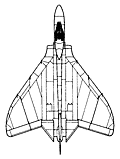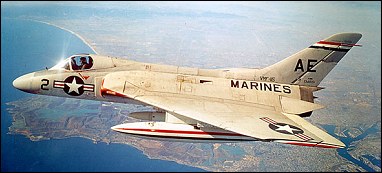|
| US Navy interest in German delta-wing research led, in 1947, to the design by Douglas of a carrier-based interceptor which embodied a variation of the pure delta wing. Approval of the Douglas design was signified by the award of a contract for two Douglas XF4D-1 prototypes on 16 December 1948, the first making its maiden flight on 23 January 1951 powered by a 2268kg thrust Allison J35-A-17 engine. This represented an emergency powerplant, resulting from delays in development of the Westinghouse J40 turbojet which had been the planned engine. Both prototypes were flown subsequently with the XJ40-WE-6 developing 3175kg thrust and the XJ40-WE-8 which had a rating of 5262kg with afterburning, but problems with this engine programme led to final selection of the Pratt & Whitney J57 engine for production aircraft.
The F4D Skyray was a cantilever mid-wing monoplane, the wing of modified delta configuration incorporating elevons to serve collectively as elevators or differentially as ailerons. The tail unit had only swept vertical surfaces, landing gear was of retractable tricycle-type and the pilot was accommodated well forward of the wing in an enclosed cockpit that provided excellent visibility.
The potential of the F4D was demonstrated effectively by the second prototype on 3 October. 1953, then powered by the XJ40-WE-8 turbojet, which set a new world speed record of 1211.746km/h. The first production F4D-1 was flown on 5 June 1954, powered by a Pratt & Whitney J57-P-2 turbojet developing 6123kg thrust with afterburning, but it was not until 16 April 1956 that deliveries began, initially to US Navy Squadron VC-3. The 419th and last production aircraft was delivered on 22 December 1958, but in the intervening period a change had been made by installation of the higher-rated J57-P-8 engine. All aircraft retained the F4D-1 designation, the popular (derived) name being Ford.
At the peak of its utilisation, the Skyray equipped 11 US Navy, six US Marine and three reserve squadrons, but none was used operationally. The type survived in first-line service until the late 1960s, with two front-line squadrons not converting to the type until 1964. It was redesignated F-6A in September 1962.

| MODEL | F4D |
| CREW | 1 |
| ENGINE | 1 x Pratt & Whitney J57-P-8B turbo-jet, 64.5kN with afterburner |
| WEIGHTS |
| Take-off weight | 11340 kg | 25001 lb |
| Empty weight | 7268 kg | 16023 lb |
| DIMENSIONS |
| Wingspan | 10.21 m | 34 ft 6 in |
| Length | 13.93 m | 46 ft 8 in |
| Height | 3.96 m | 13 ft 0 in |
| Wing area | 51.75 m2 | 557.03 sq ft |
| PERFORMANCE |
| Ceiling | 16765 m | 55000 ft |
| Range | 1931 km | 1200 miles |
| ARMAMENT | 4 x 20mm cannons, 1814kg of weapons on six hardpoints |
 | A three-view drawing (1693 x 1520) |
| Mac Bowers, e-mail, 30.07.2012 19:03 From July 59 untill July 62 I was an E5 AM in VF-13 at Nas Cecil Field Fla. While deployed on both the Essex (CVA-9 and the Shangri-La (CVA-38 we had the F4Ds and lost two Pilots. LT David Ayers and LTJG James Hannon. I was sent to Flight Control school at the old NARF in Jacksonville. I recall having to rig flight controls on a very regular basis due to the hard landings. The ELEVON system had tandem cylinders in the wing butts that incorporated a .3000IN. dead spot for the neutral position. I found it a very interesting Aircraft to maintain due to it's flight controls for example,1 no elevator or ailerons these were incorporated into the ELEVONS. 2. no flaps but did have a surface called Pitch Trimmer. My first Co was CDR Norm Berree(now deceased) All the Pilots were very good at flying the aircraft which had to be more difficult than others due to it's unusual design. reply | | J. D. Bible, e-mail, 16.07.2012 23:04 I flew the F4D-1 in several USMC squadrons, VMF(AW)-314, 513 & 542 and did an overseas tour in WESTPAC in VMF(AW)-314. Loved it!! The "FORD" was not the fastest aircraft in the sky, the F-8 and the USAF F-101 were definitely faster, but they were not nearly as agile. We were transonic and they had speed advantage. However,we always ended up on their tails if they didn't runaway from us. But considering what was available at the time, it was a very enjoyable fighter to fly!
Looking back, the F4D was occasionally grounded for improvements\\maintenance issues, so we got flight time in the F3D, AD, F9F, or whatever was available. Interesting times. reply | | Greg Hall, e-mail, 24.05.2012 03:39 My Father, Don Lawler Hall flew this aircraft and competed in the 1959 Naval Weapons Meet in Yuma and was the champion. I have an acrylic encased display commemorating it with a model of the F4D Skyray (that use to be his), patches of his squadron and the meet, a photo, and the plack that he received as champion. reply | | Bud Frazier, e-mail, 01.05.2012 02:17 Had the pleasure of doing flight test during the mid 50's at LAX on the F4D and the F5D proto model.Great aircraft. reply | |
| | bombardier, e-mail, 02.09.2011 11:24 That plane was so unstable.Only the best pilots could fly the thing.However it had a tremendous climb rate. reply | | Ernie Hiscox, e-mail, 16.03.2011 22:30 My other relationship to the F4D was teaching maintenance on the APQ-50 fire control radar at FAETUPAC. One of my students worked the F4D trainer at the other end of North Island and gave me a flight. I landed several feet below the runway damaging my ego and nothing else. reply | | Ernie Hiscox, e-mail, 16.03.2011 22:11 I was TDY with VA 126 at El Centro, and I had the mid line watch. Only three A /C to monitor so I was glad when some F4Ds started doing touch and goes. landing on dual runways meant three rows of lights on one side and only one on the other. Not symmetrical at all. I was wondering what it would look like to have two sets of lights on both sides of the landing A /C. Apparently, one pilot was reading my thoughts or having a similar day dream. He was dead center between the lights. I realized he was landing in the sand, and I started the jeep to at least get some light on the scene. We were synchronized. He hit the afterburner as I hit my ignition. Could that A /C climb. A few months later there was an Anon Y Mouse report of the incident in the NAVAIR magazine. Wonder if the pilot is still around. reply | | C.J.Weins, e-mail, 12.03.2011 02:02 Was with VMF(AW) 513 from 1961 to 1962 as the S-2 chief.We
had lost one pilot on a night sortie, flying the F4D's out of NAS Atsugi. Also we had one of our pilots 1stLt W.Olson assist a fellow pilot from MACS-6 flying a cougar jet who lost all radio /nav equip and had guided him to a safe landing. All in all the Sgn pilots felt the Skyray was the sports car they always wanted. Semper Fi reply | | Jimmye L. Jones, e-mail, 08.03.2011 19:08 I was an ordnance man with 115 at cherry point. I love to work on this airplane. However I a was happy tp see the f4b phantoms. reply | | Wilber Rea, e-mail, 14.02.2011 21:51 Guys I shore don't know what aircraft You are talking about.
I served with Mars 37 at El Toro 55 to 57. We always had one of the sob's in our hanger. One of them put me in the hospital for five days with a leg injury. I was also disappointed to see one of them go down and kill it's squadrons CO.
The gages said that the fuel had been transfered to the main tank, it had NOT. The gages and the pump did not work.
The fuselage stayed intact except it parted just behind the cockpit and killed the pilot. The title Ford was widely used as a swear word and meant FIX OR REPAIR DAILY and did not mean stability.grumps reply | | Walt Bjorneby, e-mail, 05.02.2011 08:35 Used to dogfight the Reserve Fords out of NAS Olathe KS. We had F102s at Richards-Gebaur AFB MO. Deuce was faster and could outturn the Fords especially above 35,000, and fly higher, too; it had more wing area. Had a Deuce at 59,000 once on a test hop. reply | | jim mcgechie, e-mail, 07.01.2011 02:41 served with jg brickner vf-102 How cn I contack him? I was his plane captian at one time on a F-4D, reply | | Gary Gebo, e-mail, 09.12.2010 07:02 I flew the Ford In 1961 to1962. Had a cruise on the Independence the summer of 1962. A great performing aircraft! Nothing could out turn you, and nothing could out climb you! A truly great experience. reply | | l, e-mail, 13.11.2010 02:12 Remember working at Douglas /Long Beach 1950's and riveting front leading edge of the wings. Very compact work. reply | |
| | Don McDonald, e-mail, 29.10.2010 23:06 I deployed with VMF-115 as a radar /guided missile technician to NAS Atsugi, Japan in Jan, 1958. We and our F4Ds relieved VMF-513 and their older F3Ds. About Sep,1958 the entire MAG was sent to Ping Tung, Formosa. While there, we flew CAP flights protecting the Nationalist Chinese transports re-supplying Quemoy and Matsu islands just off the Chinese mainland. We returned to Atsugi about Mar 1959 then on to the US in Apr or May, 1959.
Upon returning to the US, I was assigned to VMF-513, by then equipped with F4Ds, and participated in the Naval Weapons Meet in Yuma, AZ in Dec 1959.
Several other postings cover the same units and period of time but I don't recognize any of the names. It was still great to read the postings that stirred the memories. reply | | Howard Nickerson, e-mail, 25.10.2010 00:52 Flew the F4D in VF(AW)-3 in 1958. reply | | Don Safer, e-mail, 17.10.2010 22:51 I went to San Diego boot camp across the bay from North Island NAS September to December 1962. At night durring the first week or two we would hear this huge roar from across the bay and witness a tongue of flame leaping into the sky. We figured they were some sort of rockets. Then we heard it durring daylight and realized they were Skyrays going nearly verticle on afterburner after leaving the runway. I found out latter they were part of the air defense system. The Airforce had the duty around the rest of the country, probably with F-106s, but the Skyray, with it's very fast climb rate, had the duty for the SW corner of the country.
By the time I was stationed at North Island with VAW-11 in February of '64, they were gone. reply | | John Melvin, e-mail, 22.09.2010 08:26 A question for all: When the main gear retracts which way does it lay in the wing. Is the strut on top or the wheel on top? reply | | Jim Campbell, e-mail, 21.09.2010 04:26 For those interested there is a newly released book titled "Killer Rays" written by Mark Frankel that can be ordered from Specialty Press at 800-895-4585. The book briefly covers all delta winged aircraft but is primarily on the F4D Skyray. reply | | Jim Campbell, e-mail, 21.09.2010 04:25 For those interested there is a newly released book titled "Killer Rays" written by Mark Frankel that can be ordered from Specialty Press at 800-895-4585. The book briefly covers all delta winged aircraft but is primarily on the F4D Skyray. reply |
|
Do you have any comments?
|
| 
COMPANY
PROFILE
All the World's Rotorcraft
|








